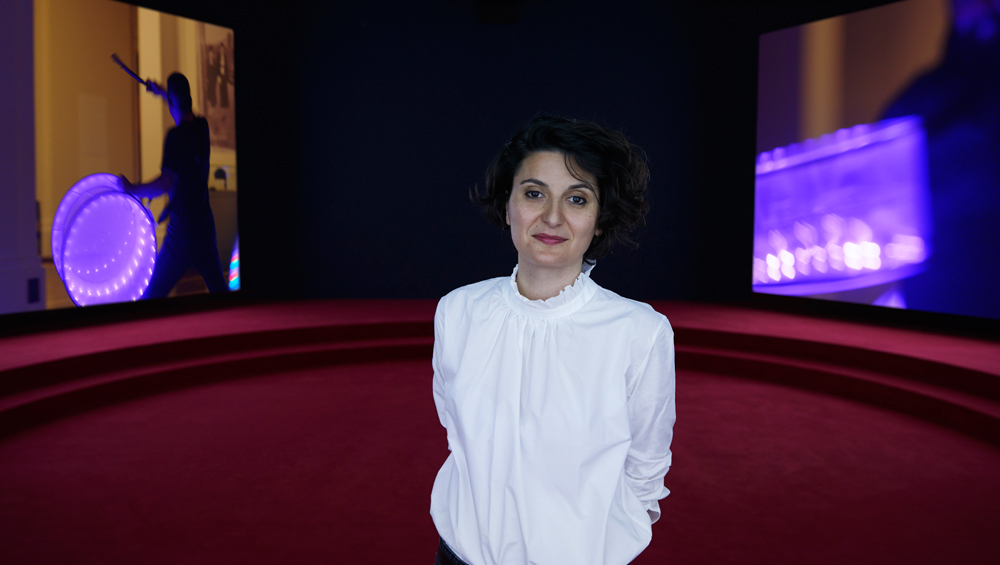
Portrait of Angelica Mesiti in her exhibition ASSEMBLY, 2019. Commissioned by the Australia Council for the Arts on the occasion of the 58th International Art Exhibition – La Biennale di Venezia, courtesy of the artist and Anna Schwartz Gallery, Australia and Galerie Allen, Paris. Photography: Zan Wimberley.
by ALLIE BISWAS
Assembly, an ambitious video work by Angelica Mesiti, which debuts this week at the 2019 Venice Biennale, takes a 19th-century stenographic device as its starting point. Resembling a piano keyboard, the Michela, invented by Antonio Michela Zucco, was originally inspired by the notion of musical notation as a universal language. Practical requirements, however, took precedence: the Michela became an administrative aid in the Italian senate for official parliamentary recording, where it continues to be used. The object’s vast poetic potential had never been realised – until it came to Mesiti’s attention. The artist (b1976), who grew up in Sydney and now spends her time between there and Paris, uses the device to transcribe a poem by the Australian poet David Malouf. This is then arranged into a musical score and performed by a group of musicians. As the music is played, dancers, who all hail from Australia and represent the diversity of the country, disassemble and come together through choreographed movement.
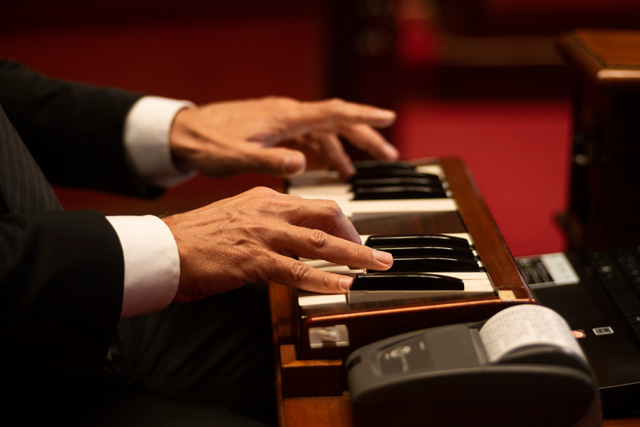
Angelica Mesiti, ASSEMBLY, 2019 (production still) three-channel video installation in architectural amphitheater. HD video projections, colour, six-channel mono sound, 25 mins, dimensions variable. © Photograph: Bonnie Elliott. Commissioned by the Australia Council for the Arts on the occasion of the 58th International Art Exhibition–La Biennale di Venezia, courtesy of the artist and Anna Schwartz Gallery, Australia and Galerie Allen, Paris.
Music has played a longstanding role in Mesiti’s work. She developed an acute awareness of sound during her extensive training as a dancer when she was growing up. The videos she has been making over the past decade, a critical selection of which are on display at the Palais de Tokyo in Paris, frequently incorporate people playing music or interacting with sound. In Citizens Band (2012), four musicians are featured separately in diverse locations, immersed in performing the traditional music of their home country. Relay League (2017) revolves around a percussionist, a choreographer and two dancers, offering an examination of the role that sound and movement can play as a form of non-verbal communication. The way in which songs and music-based rituals form communities is indicated through the Danish inhabitants of Aarhus, whom Mesiti chose to film in Mother Tongue (2017). In all these works, Mesiti unravels the beauty of everyday occurrences that exist as non-linguistic apparatus, while showing the social and political qualities inherent in such actions.
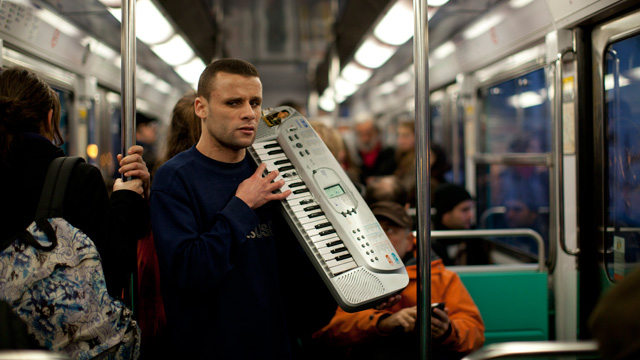
Angelica Mesiti, Citizens Band, 2012 (still). Four-channel High Definition video, 16:9, colour, sound, 21 min 25 sec. Courtesy the artist and Anna Schwartz Gallery.
Here, Mesiti discusses her career to date, and her thoughts on staging her work at the Venice Biennale.
Allie Biswas: Tell me about your training in dance.
Angelica Mesiti: For 10 years, as a young person, I did classical ballet and contemporary dance training. After high school, I got a scholarship to do a short residency at a dance centre in London. Then I decided to go to art school. I felt as though there were a lot of things that I wanted to explore outside dance.
AB: How did your interests develop at art school?
AM: I gravitated towards the time-based media department, which encompassed performance, experimental film and sound art. I felt my background in dance attracted me to those forms. I started working with a Sydney-based dancer who was trained in Butoh, a form of Japanese dance theatre. She introduced me to “Body Weather” and site-specific choreography. This period during my education allowed me to open up my mind to what performance could be and how it fits into the history of contemporary art, and also how film and video are related to that history.
AB: Can you talk a bit about what Body Weather is and the impact it has had on your work? What are the main qualities of this type of performance?
AM: It comes out of Butoh training, but it goes in another direction led by certain people. It is a choreography that is in stark opposition to a lot of classical and contemporary dance, which is narrative driven and uses a kind of psychology or emotive storytelling. The choreography in Body Weather is driven by articulations and instructions based on muscles and bones. It is not driven by aesthetic at all. The movement is a consequence of certain instructions relating to speed and pace. That was pretty mind-blowing for me. It was almost the opposite of what I learned through my training.
Later on, I did a workshop at the Kitchen in New York. I got to do a masterclass with Pauline Oliveros. I had been really interested in experimental sound at art school and had got involved with an artist-run space. We put on a lot of sound nights and hosted a radio show. These were the kind of things that were feeding into my development.
AB: When did you really start to think about making video works?
AM: I guess a lot of things were happening in parallel. I was studying moving image practice and also working with a performance collective. We were making a lot of video works together. My role in the group was coming from a video art background – I was quite involved in the production process. For a brief time, I was also an editor on feature films and television shows, so I had knowledge of the craft as well. I spent a lot of my 20s building up my skills.
AB: I think that comes across in the tone of your works. Are you interested in relaying specific technical qualities in your film-making?
AM: When I finished art school, portable video cameras were really coming on to the market. At that time, I was into the accessibility of these types of hand-held cameras and the kind of images they produce, which are immediate, pretty shaky – pure documentation. At the same time, I was working with film-makers and had a love of cinema. I was starting to feel as though there was a limitation with that form of documentation. There was a barrier between the viewer and the image, in that it was so de-aestheticised that it was hard to have an emotional connection with the subject.
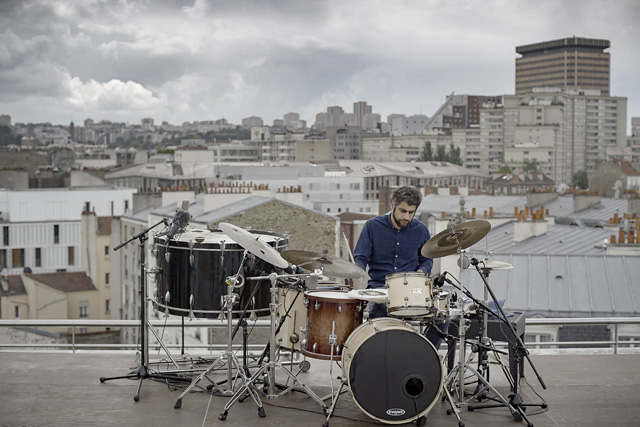
Angelica Mesiti, Relay League, 2017 (still). Three-channel High Definition video, 16:9, colour, sound, 9 min 11 sec. Courtesy the artist and Anna Schwartz Gallery.
In the collective, we were using strategies of irony and parody in our work and when I shifted into my own practice, I wanted to see what could be explored through searching for beauty – and not traditional forms of beauty. I felt there was another aesthetic approach that would help me to achieve the kind of intimacy I was looking for in my work. That’s why I made the decision to work with cinematographers. I wanted to take this cinematic approach, in which I use really conventional forms of editing and sequencing of images because there is this common language of watching things that we all share, and I wanted to work with that.
AB: Where do you think narrative comes into your work?
AM: I form images with the history of contemporary art behind me, rather than a film-making background. I am not particularly interested in narrative. I don’t see myself as a storyteller. For me, it feels more natural to construct works that accumulate in meaning rather than have a sequential story. That’s why the single screen is not really my way of working. I like working across multiple screens so there is a plurality or ideas happening at once.
AB: Movement and sound is always highlighted as a primary way of communicating, and you often pick up on types of communication that are archaic or have become derelict. Your newest work, Assembly, stems from a 19th-century stenographic device. Where do you start with language in your work?
AM: I have been trying to answer that question myself. I don’t think I am drawn to the nostalgia of these obsolete activities or objects. I think I have realised that it’s what happens with the way that something ends and then something new emerges out of that ending – the creativity that is generated out of limitations or some kind of adversity or crisis. I am fascinated by that creative impulse to generate or adapt. And I guess you often find that around something that has become obsolete. Derelict is an interesting word to use.
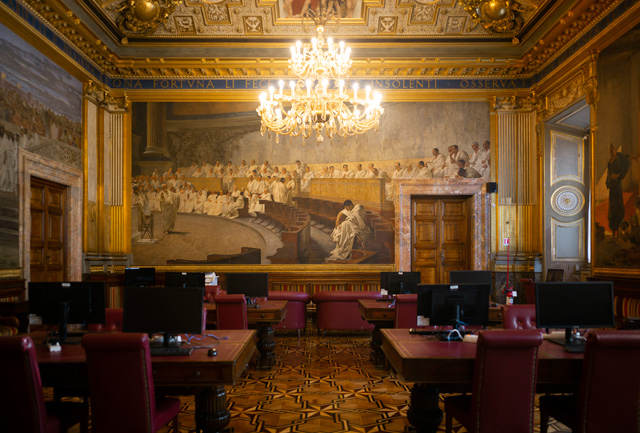
Angelica Mesiti, ASSEMBLY, 2019 (production still) three-channel video installation in architectural amphitheater. HD video projections, colour, six-channel mono sound, 25 mins, dimensions variable. © Photograph: Bonnie Elliott. Commissioned by the Australia Council for the Arts on the occasion of the 58th International Art Exhibition–La Biennale di Venezia, courtesy of the artist and Anna Schwartz Gallery, Australia and Galerie Allen, Paris.
AB: The themes of translation and transformation also often frame your work.
AM: Perhaps that’s my way of working around the conventions of narrative. When I am developing a work, there are a number of extrapolations that reveal themselves within the idea. If they emerge, I try to follow them to see where they will lead. I am interested in the multiple possibilities of a translation of an idea, across formats or forms.
AB: Where does this continuing interest in musicians come from?
AM: I have always been drawn to musicians. I wonder if it’s because, with dance training, your ear is tuned to music very early. Music is this kind of ignition that is a way of connecting this physical experience. I grew up with that relationship to music. As a medium in my work, it is very useful, because of music’s emotive powers. It goes beyond language. It’s a medium that you can use to connect across various audiences.
AB: You also have a preoccupation with documenting groups. Is there a specificity to the people you choose to use as your subjects?
AM: In Citizens Band there was. I was drawn to those people because they were unique and quite outstanding performers. I encountered Mohammed on the metro. I heard about Geraldine through a friend and hunted her down. Once that I could see there was a work emerging, that there was a relationship between the two of them, and I had started to build the idea, I went looking specifically for Asim and Mohammed who were the particular type of performer I had been looking for.
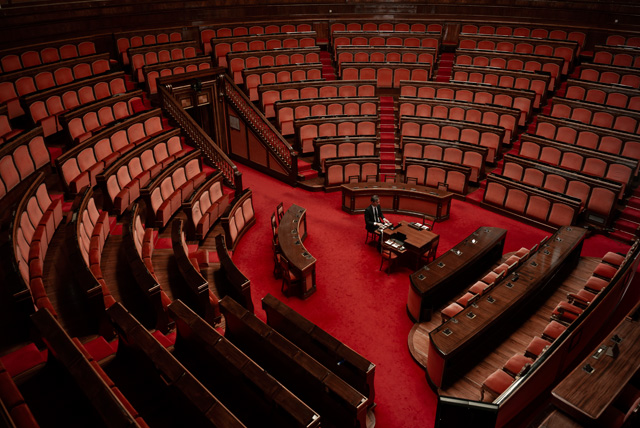
Angelica Mesiti, ASSEMBLY, 2019 (production still) three-channel video installation in architectural amphitheater. HD video projections, colour, six-channel mono sound, 25 mins, dimensions variable. © Photograph: Bonnie Elliott. Commissioned by the Australia Council for the Arts on the occasion of the 58th International Art Exhibition–La Biennale di Venezia, courtesy of the artist and Anna Schwartz Gallery, Australia and Galerie Allen, Paris.
AB: Was your interest in them to do with how they performed rather than their individual stories? The group's common factor, of course, is that they are all transplants, having left their home country. Geraldine moved to Paris from Cameroon; Mohammed moved to Paris from Algeria; Asim moved to Australia from Sudan; and Bukhchuluun Ganburged moved to Australia from Mongolia.
AM: It was both. it was this idea of cultural remembrance happening through musical performance outside their place of birth. But I was also looking for performers who could match Mohammed and Geraldine, who were extraordinary.
I think particularly in the new work, Assembly, I am interested in the individual and the group. I am regenerating an ensemble out of individuals who are separated from each other physically on the screen or through their stories. In some ways, I am putting a band or orchestra together and each of them is playing a part within the grander story of the work. But I’m also interested in generating communities within the experience of the work itself. I think a lot about the audience: where they are situated, how they are physically required to engage with the work.
AB: Are there any political motivations regarding the people who feature in your work?
AM: Sometimes I am interested in particular people or groups of people because there is a perception that I want to challenge, because I sense there is a need to challenge that perception. We are all making works in the context of the times we’re living in.
AB: How did Assembly, your exhibition for the Australian Pavilion at Venice, come into being?
AM: I had come across this stenographic machine in Italy three years ago, at a flea market. I had been interested in it as a device, but didn’t know what to do with it. It is a 19th-century invention based on a piano keyboard, with black and white keys. It is a typewriter, effectively. It is used for parliamentary reporting, by stenographers. What was immediately interesting to me about the device was that it was two things simultaneously: it was potentially a musical instrument and a typewriter at the same time. Logically, I knew there would be a way in which you could translate text into music, or notation. When it came to developing an idea for the Venice proposal – the Australian Pavilion had put out an open call – I thought this could be a good moment to play with the device. It has had an interesting role in parliamentary proceedings over the past 100 years, bearing witness to a lot of historical events. I thought it had a lot of poetic potential.
AB: The video opens with a visual of the machine.
AM: We start with the machine, with one of the people from the stenographic department in Rome typing out a poem by an Australian poet, David Malouf. This poem was written in 1975 – it’s the perspective of an individual who is contemplating this linguistic link that has been broken between him and an ancestor, his grandfather. It’s about the impossibility of translation. The poem was typed on the machine and then we took that code and translated every impression of the keys as the stenographer was typing the poem. We have recorded that information as musical notation – musical notes. I worked with a composer called Max Lyandvert, who has arranged those notes into a score that is then played by a series of musicians who form an ensemble in the work.
Originally, the material was quite atonal, because it’s generated without any musical intention. Max drew out the musicality within it through adjustments of tempo and distribution of notes across different instruments. It starts with instruments that you would find in classical performance – viola, piano and clarinet – and they are performing every note as it is received. As the work evolves, musicians from different backgrounds join that ensemble through improvisation, to develop the music, so that it turns into something new.
AM: You use musical tropes to explore the complexities of being part of a group – of wider communities.
AM: Polyphony is pretty central to this work. This is generated by distinct and individual notes or sounds or melodies, and when these things join, they turn into their own form of musical sound. And it is not harmony. That’s the metaphor I’m really chasing in this work – that dissonance is part of a process and not something to be afraid of. I was being very wary in the making of this work. I really don’t want to make something that ties everything up in a bow, or ends in a simple conclusion. I really want to maintain ambiguity and possibility.
AB: How does it feel to be the sole artist representing the Australian Pavilion?
AM: I don’t like the idea of representing a country. I like to think, rather, that I have been chosen to present something for my country. I saw the biennale as an interesting context in which to present some perspectives that are not what Australian identity is generally expected to be – and to challenge what that perception is, anyway. The work is shot in Australia but, as with my other pieces, it could be anywhere. I have tried to find environments and situations that are not specific to a place.
• Assembly is on display at the Australian Pavilion at the 2019 Venice Biennale until 24th November. When Doing Is Saying, Mesiti’s first institutional solo exhibition in France, is on display at the Palais de Tokyo until 12 May.